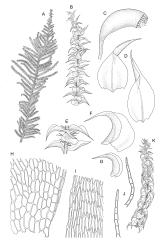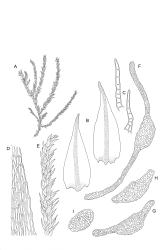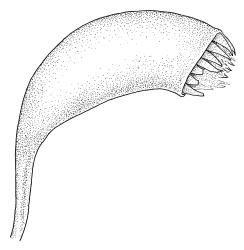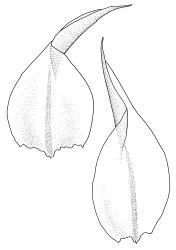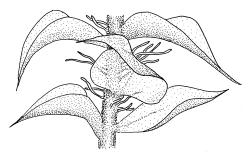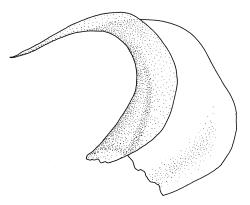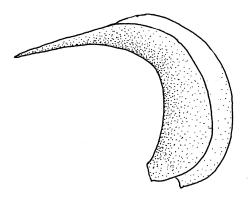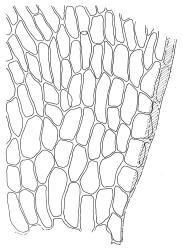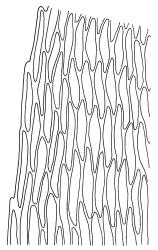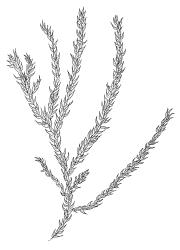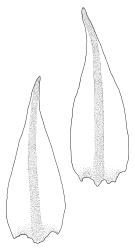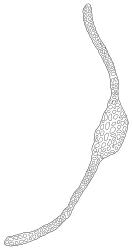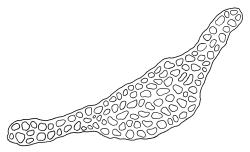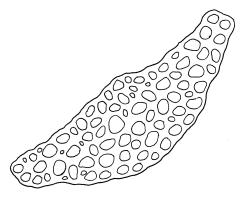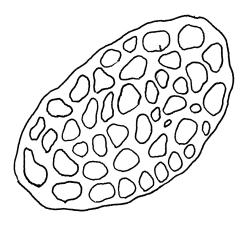- ≡ Hypnum relaxum Hook.f. & Wilson in Wilson, Bot. Antarct. Voy. II (Fl. Nov.-Zel.) Part II, 110 (1854)
- ≡ Campylium relaxum (Hook.f. & Wilson) Broth., Nat. Pflanzenfam. [Engler & Prantl] 1(3), 1044 (1908)
- = Hypnum decussatum Hook.f. & Wilson in Wilson, Bot. Antarct. Voy. II (Fl. Nov.-Zel.) Part II, 110 (1854)
- ≡ Campylium decussatum (Hook.f. & Wilson) Broth., Nat. Pflanzenfam. [Engler & Prantl] 1(3), 1044 (1908)
- ≡ Cratoneuropsis decussata (Hook.f. & Wilson) M.Fleisch. ex Broth. in Brotherus, Nat. Pflanzenfam., ed. 2 [Engler & Prantl] 11, 334 (1925)
- = Sciaromium bellii Broth., Öfvers. Finska Vetensk.-Soc. Förh. 40: 189 (1898)
- = Hypnobartlettia fontana Ochyra, Lindbergia 11: 3 (1985)
The following description encompasses the variation of the "relaxa" growth form and the "decussata" growth form only.
Plants medium-sized to robust, highly variable in size, branching and set of leaves, usually yellow-, brown-green or bright green, often darker in lower portions, mostly aquatic, emergent, or in damp sites, often in areas of constant irrigation and forming extensive and dense mats. Stems highly variable in length (mostly c. 100–150 mm, rarely to c. 250 mm), either subpinnately or irregularly branched, often self-supporting and suberect, in cross-section lacking a hyaloderm, with 3–5 layers of thick-walled cortical cells, with central strand weak or lacking; rhizoids smooth and red-brown, in fascicles arising below leaf insertions. Stem leaves squarrose-recurved or spreading, acute from a broadly ovate base, about twice as long as wide, mostly strongly constricted at mid leaf (and hence strongly reflexed to squarrose), weakly narrowed to insertion, weakly to strongly cordate at base, often eroded on lower stems and sometimes persisting as costae only, recurved at mid leaf margins, strongly concave to tubulose, denticulate or occasionally nearly entire, not or very weakly bordered, commonly 1.2–1.8 × 0.6–0.9 mm; mid laminal cells unistratose, vermiculate to oblong-hexagonal, firm-walled, not porose, not or weakly prorate, mostly (15-)30–35 × c. 6–9 µm, becoming more regular and ± rectangular towards leaf base; alar group small and ill-defined, the cells subquadrate or ± oval, firm-walled, slightly inflated or compact, often darker green than adjacent cells. Costa single, well-defined, evenly tapered, variable in basal width (c. 45–100 µm), fading below the leaf apex or percurrent, in cross-section at mid leaf homogenous (lacking both guide cells and stereids), 3–6 cells thick; branch leaves not differentiated or smaller and less squarrose than stem leaves. Axillary hairs 2-celled, with an elongate terminal hyaline cell. Paraphyllia abundant or sparse on stems and branches, filamentose or narrowly lanceolate, from 1–4 cells wide at base.
Dioicous. Perichaetia scattered on stems, with inner perichaetial leaves lanceolate, to c. 3.5 mm, weakly costate, plicate, sheathing the seta base. Perigonia scattered on stems, inconspicuous, c. 0.8–1.0 mm, with bracts concave, weakly costate and often ± secund. Setae elongate, straight, smooth, twisted to the right above, red when fresh but fading with age, c. 30–38 mm; capsules oblong or short-cylindric from a well-defined and curved neck, c. 3 mm, strongly inclined or horizontal, strongly constricted below the mouth when dry; exothecial cells firm-walled, ± oblong; annulus not differentiated. Operculum high-conic, acute to weakly apiculate. Exostome teeth yellow-brown, distinctly bordered; endostome well-developed, with single or paired nodose cilia. Calyptra as per family. Spores 12–15 µm, smooth or nearly so.
Wilson 1854, pl. 90, fig. 1 (as Hypnum relaxum); pl. 90, fig. 2 (as H. decussatum); Brotherus 1925, fig. 672, a–d (as Cratoneuropsis decussata); fig. 672, e–f; Scott & Stone 1976, pl. 80; Ochyra 1985, fig. 1–2 (as Hypnobartlettia fontana); Allison & Child 1971, pl. 30; Beever et al. 1992, fig. 76; Malcolm & Malcolm 2003, p. 13; Meagher & Fuhrer 2003, p. 57; Seppelt 2004, fig. 45.
In its "relaxa" growth form and its "decussata" growth form, Cratoneuropsis relaxa is highly distinctive and confusion with other N.Z. species seems unlikely, although confusion with the adventive species Rhytidiadelphus squarrosus is conceivable. These two species can readily be distinguished by the nature of their costae (strong and single in C. relaxa; short and double in R. squarrosus), the presence/absence of paraphyllia, and other microscopic differences, as well as by habitat. Depauperate plants growing on dry rocks could be confused with Amblystegium varium (see that species for comparisons).
Seppelt (2004, p. 116) suggested that C. relaxa had the "outward appearance of a large Thuidium".
NI: N Auckland (Waipoua, Waitakere Range, Hunua), S Auckland (Stony Bay), Gisborne, Hawke’s Bay, Taranaki, Wellington; SI: Nelson, Marlborough, Canterbury, Westland, Otago, Southland; St; Ch; A; C; M.
Australasian or Austral. Tasmania*, Australia*. Recorded from S Africa by Scott & Stone (1976).
Cratoneuropsis relaxa is an extremely variable species occupying a wide range of habitats throughout the main and southern offshore islands of N.Z. It is best developed on irrigated and shaded rocks and soil in habitats such as the margins of waterfalls, stream beds, and in seepages. In permanently irrigated and/or dripping sites this species often forms extensive mats, sometimes a square metre or more in extent. In such hypermoist and shaded sites, C. relaxa will grow over all available surfaces, including wood, and rarely can be epiphytic. Also found at lake margins and, less commonly, in wetlands. Occurring over a wide range of substrates including greywacke, schist, basalt, papa, limestone, gravel, sand, and even peat. In irrigated habitats it is usually easily recognised by its habit, its grapnel-shaped leaves, and abundant paraphyllia. In such sites it may be associated with a wide range of species including Achrophyllum spp., Brachythecium rutabulum, Breutelia pendula, Distichophyllum microcarpum, Drepanocladus aduncus or D. brachiatus, Fissidens rigidulus, Plagiomnium novae-zealandiae, and Tridontium tasmanicum.
On the North I. the "relaxa" growth form of C. relaxa occurs from near sea level to at least 1280 m (near Kime Hut, Tararua Range, Wellington L.D.) and on South I. to c. 1550 m (Mt Arthur, Nelson L.D.).
Scott & Stone’s (1976, p. 414) description of well-developed plants from irrigated sites can scarcely be improved upon: "In its most perfect development, it has long shoots to 20 cm (the Handbook gives an extreme of 15 cm in New Zealand), densely pinnately branched to give a feather-like frond, soft and woolly with very closely imbricated leaves which are widely spreading, with the leaf tips tightly hooked backwards like a grapnel."
In more mesic habitats C. relaxa is a generally smaller and more delicate plant. Such variants were given the name Hypnum decussatum Hook.f. & Wilson (and subsequent combinations); they are here referred to as the "decussata" growth form. The variability of this growth form is encompassed in the above species description. Sainsbury (1955, p. 430) discussed the differences between C. relaxa s.s. and C. decussata at some length. Scott & Stone’s (1976, p. 414) reference to "two very different-looking plants encompassed by the range of variation of this species", refers to such material. I concur with both Sainsbury (1955) and Scott & Stone (1976) that Cratoneuropsis decussata is undeserving of formal taxonomic recognition.
The lectotype of Hypnum relaxum Hook.f. & Wilson was collected by D. Lyall from "Port Cooper"; this is an historical name for what is now Lyttelton Harbour fide Godley (1967). Two other syntypes (W. Colenso 237 from "Northern Island" and E.F.A. Raoul 99 from "Akaroa" on the Banks Peninsula have also been seen in BM; both are representative of what is termed here as the "relaxa" growth form of C. relaxa.
The lectotype of Hypnum decussatum Hook.f. & Wilson differs from the type of H. relaxum primarily by having branching more regularly pinnate, branch leaves more strongly reflexed and more compactly inserted, and stem leaves c. 1.2 × 0.8 mm (observed with difficulty) with mid laminal cells mostly 20–27 µm and lower costae c. 60 µm wide. All these measurements lie in the lower range of continuous variation for C. relaxa. The lectotype conforms in all features to a collection by W. Bell from Mt Earnslaw (Otago L.D., CHR 621730) which was determined by Brotherus as "Hypnum decussatum". In these and other specimens of the "decussata" growth form the alar cells are quite compact and the leaf margins nearly entire. Such plants grow on calcareous or nutrient-rich rocks. Associated species in mesic to dry habitats include Austrohondaella (Isopterygium) limata, Rhynchostegium tenuifolium, Sauloma tenella, Syntrichia anderssonii, and the lichen genus Leptogium. I concur with the opinion of T.W.N. Beckett (in herb.) that: "[He] consider[ed] that [Hypnum] relaxum and [H.] decussatum are but one species".
C. relaxa may also grow abundantly fully submerged; in such conditions the leaves are broadly ovate and not reflexed. Such plants have been named as Sciaromium bellii Broth. Sainsbury (1948; 1955) was the first to treat S. bellii Broth. as a synonym of C. relaxa and his placement is followed here. The type and similar plants are here termed the "sciaromium" growth form. Plants of this growth form are widespread on both main islands.
Type material of S. bellii has ± straight and broadly ovate leaves which are scarcely cordate at base and costae which are c. 60 µm wide below and percurrent. There is some tendency for a weak border of thicker-walled cells to develop in the lower portion of the leaves. Because Sainsbury (1948) based his taxonomic conclusions on examination of the syntype from North East Valley, Dunedin, a lectotype (presumably in the Brotherus herbarium) should be designated from this locality.
In some straight-leaved populations (including ample syntype material from Lime Hills, Southland, CHR 629482) the costae can be stouter (c. 90–100 µm wide near base). Few if any collections attributable to the "sciaromium" growth form have significant areas of bistratose laminal cells. Plants of the "sciaromium" growth form can, like other growth forms, have leaves much eroded, leaving the lower stems mainly covered with persistent costae.
Collections attributable to the "sciaromium" growth form have been seen from Gisborne (Waimata), Wellington (Hutt Valley), Nelson (Travers Valley), Canterbury (Mt Misery, Castle Hill, Banks Peninsula, head of Lake Tekapō, Kimbell), Westland (Ōtira), Otago (Maungatua, North East Valley), and Southland. The most frequent associate of this growth form is Tridontium tasmanicum.
Populations exhibiting transitions between the "sciaromium" growth form and other growth forms do occur. For example, A.J. Fife & P.J. Dalton 9885 (Castle Hill, Canterbury L.D., CHR 512637) shows traits intermediate with the "relaxa" growth form and some material from Te Waikoropupū Springs (Nelson L.D., CHR 558226 and CHR 528802) shows traits intermediate between the "hypnobartlettia" and "sciaromium" growth forms, as discussed below. Such transitional material is to be expected, given the environmentally induced nature of the variants.
Dixon (1929, p. 314) suggested that material of the "sciaromium" growth form could be confused with "certain aquatic growth forms of the Hypnodendraceae", particularly of Sciadocladus kerrii or Hypnodendron marginatum. I agree with Dixon that "both of these [taxa] have narrower, ovate-lanceolate leaves, a much narrower nerve, shorter and wider cells, and a distinctly toothed margin."
Another growth form of C. relaxa, with ovate-lanceolate, non-reflexed leaves, bistratose areas in the leaf lamina, and very stout, excurrent costae (see Image: Image\1B16), is known only from the Main Spring pool at Te Waikoropupū Springs (Nelson L.D.). Plants with the above combination of features occur in abundance at depths (probably up to 5 metres or more) and were described as Hypnobartlettia fontana Ochyra (1985).
Beever & Fife (2008) discussed in detail the morphological variation of the growth forms of C. relaxa at Te Waikoropupū Springs and its tributary Fish Creek. They concluded that the available evidence indicated "Hypnobartlettia fontana" to be merely an extreme environmental growth form of C. relaxa.
The degree of bistratose laminal development varies greatly in collections from Te Waikoropupū Springs and adjacent Fish Creek. Material of the "relaxa" growth form with unistratose lamina is abundant in Fish Creek. Some material from the Main Spring pool (e.g., F. Michaelis 49, CHR 558226) has ± equal bistratose and unistratose areas of mid laminal cells. Type material of H. fontana Ochyra and other "deeply submerged" collections (e.g., collector unknown, 1958, CHR 105042A) from the Main Spring pool have the mid lamina cells entirely or very nearly entirely bistratose. All collections of the "hypnobartlettia" growth form from the Main Spring pool have sparse filamentous paraphyllia.
Beever & Fife (2008) reviewed evidence presented by Stech et al. (1999) that H. fontana and Cratoneuropsis relaxa are separable using molecular data (DNA sequences from the chloroplast trnLUAA intron) and considered that their conclusions were flawed, partly because of incorrect determinations of voucher specimens.
The main associates of the "hypnobartlettia" growth form at Te Waikoropupū Springs are Bryum blandum, Calliergonella cuspidata, Drepanocladus aduncus, Fissidens rigidulus, and Chiloscyphus austrigenus. In its "hypnobartlettia" growth form, C. relaxa could not be confused with any other aquatic moss in N.Z.




